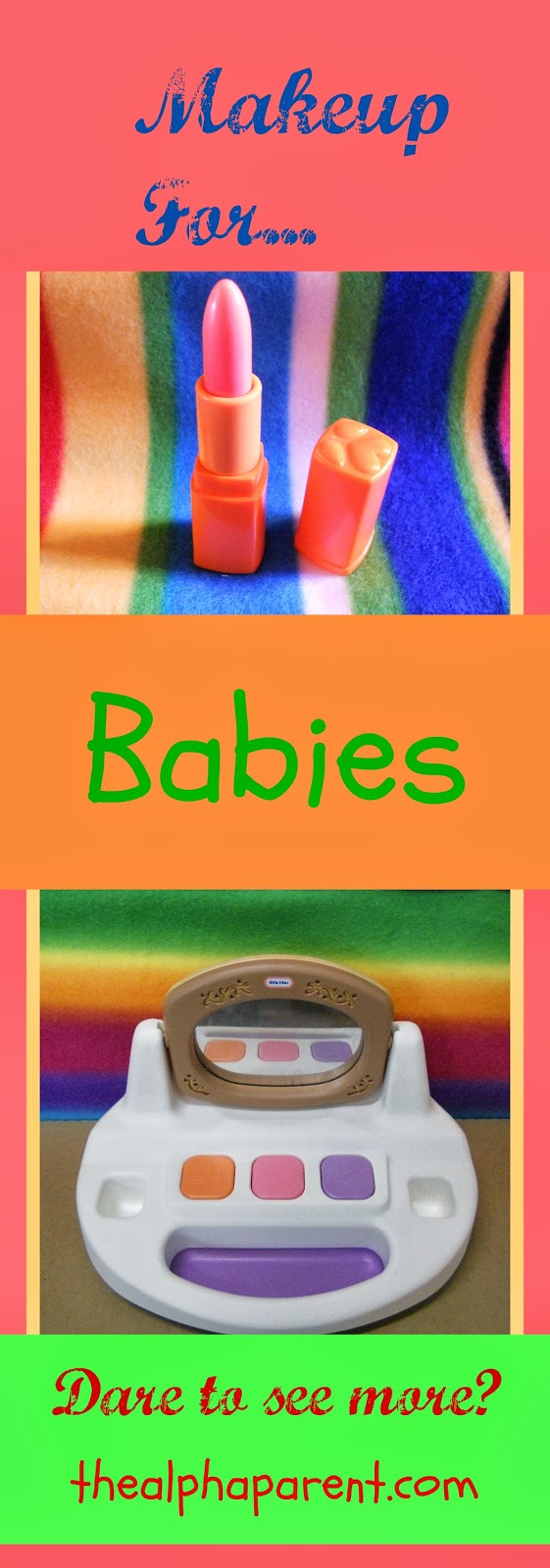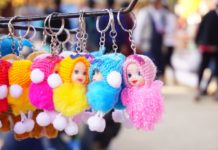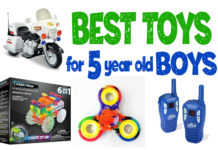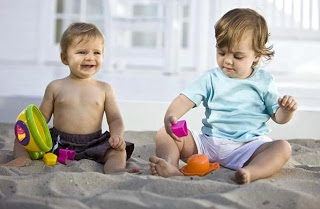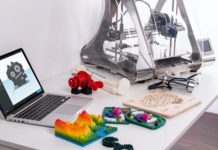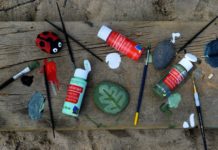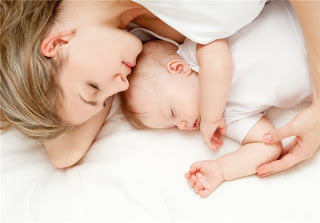 The contemporary flooding of the preschool toy market by cosmetics is well-documented. Such penetration is thought to begin when children are as young as three years old. However this article is going to focus on cosmetic-related products aimed at the under 3s. Yup, make way for makeup… for babies.
The contemporary flooding of the preschool toy market by cosmetics is well-documented. Such penetration is thought to begin when children are as young as three years old. However this article is going to focus on cosmetic-related products aimed at the under 3s. Yup, make way for makeup… for babies.
Sadly, there are more of these products in the mainstream market that you may first assume. They are designed and manufactured by both small companies and multinational toy giants; such is their omnipresent nature. The concept of beauty, make-up, and self-decoration is being introduced to infants fresh out of the womb in the form of ‘plush’ play-sets. I loathe to use the word ‘play’ in this context – the reality is that these items have a great deal to do with the indoctrination of Patriarchal beauty values and not very much to do with children’s play. The products, which are usually soft and washable or plastic and wipe-clean, exploit a baby’s natural curiosity with texture, colour and sound.
Perhaps the first, and certainly the most commercially popular, example of such products is a Fisher Price toy called “My PrettyLearning Purse” aimed at babies and toddlers aged 6 to 36 months. ‘Purse’ is the American word commonly used for ‘handbag’.
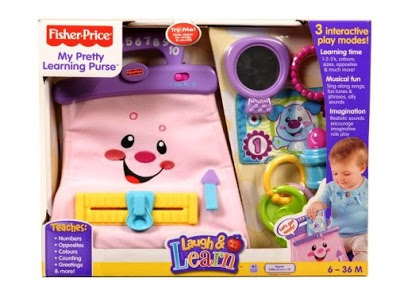
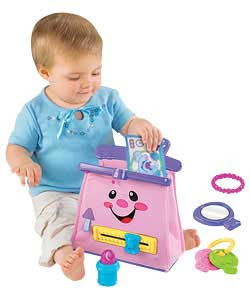
The purse comes with a lipstick, dollar bill, a bracelet, a mirror, and a set of keys. It also sings songs about purple and pink. Notice that the contents are disproportionately beauty related. The items promote physical attractiveness as the main value, complimented by consumerism. A child that is encouraged by adults to pay so much attention to her attractiveness is very prone to developing eating disorders and other self-esteem issues later in childhood.
This may sound like a sensationalist overreaction on my part; these products are aimed at babies after all, and babies have no concept of gender, let alone objectification. However it is the introduction of beauty paraphernalia into the baby’s everyday world, its familiarization and indoctrination at an unconscious involuntary level that enables these toys to set the foundation for such issues. Even before their first birthday babies can assimilate messages presented to them. Psychologists have discovered that babies know, explore, observe, and learn more than we would have ever thought possible. In some ways they are smarter than adults. Several studies show that even the youngest children have sophisticated and powerful learning abilities (Gopnik. A).
A few years after creating “My Pretty Learning Purse” Fisher Price produced an updated version in which they replaced the lipstick with a mobile phone, and replaced the dollar bill with a credit card. Thus now other buttons are being pressed as well. (Girls love to talk and spend money). Fisher Price have not retired the older version so the two products continue to be sold simultaneously.
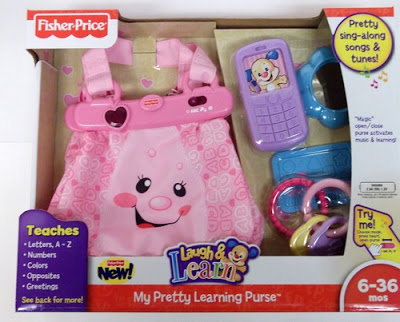
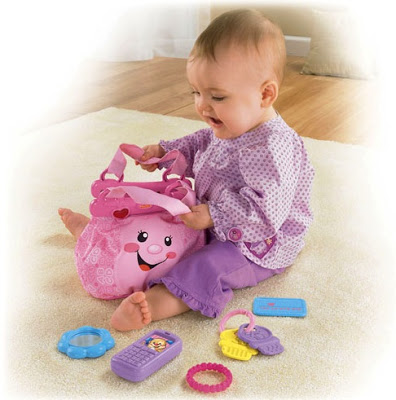
Interestingly the ‘boys’ version’ of this product comes in the form of a tool set. It includes a hammer, screwdriver, saw, and wrenches. Notice how the girls’ set is called “My Pretty Learning Purse” whereas the boys’ set is called simply, “My Learning Tools”; There’s nothing pretty about these bad boys. Instead of singing about pink and purple, the tools sing “let’s get to work!” These products are an excellent example of the common dichotomy in children’s toys – that boys make things, and girls purchase the things that boys make.
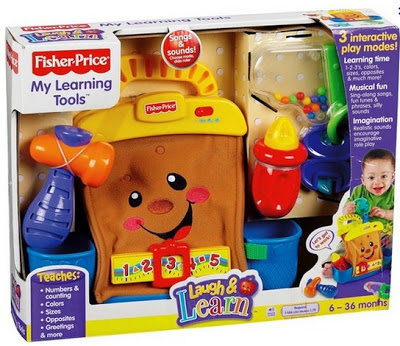
But wait! After its brief relegation, the little blue lipstick is back, in this vanity mirror by the same ‘Laugh and Learn’ franchise. It is apparent that Fisher Price didn’t learn the error of their ways after all:

The Fisher Price Laugh and Learn Magical Musical Mirror is “baby’s very own lighted, vanity mirror”. Bat at the roller-ball or open/close the compact to hear “pretty” ditties and learning songs. “The mirror fosters early role play with five play pieces: comb , powder puff, lipstick and two bracelets.” Every single item is beauty-related.

Fisher Price is not the only large toy giant to apply the cosmetics/tools gender dichotomy. Popular baby company Lamaze have also created a handbag complete with mobile phone, makeup compact and ‘posh poodle’ (Lamaze’s words). The Lamaze boys’ tool set includes various tools and a ‘busy beaver’. Lamaze claim these toys “inspire imagination”. I would argue that they actually stifle imagination. They are so detailed that it would be very difficult to put them to any uses other than the obvious ones.
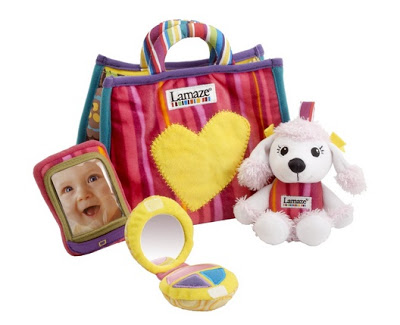
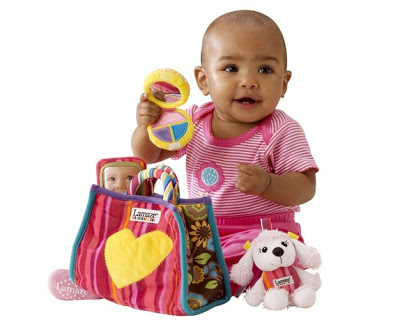
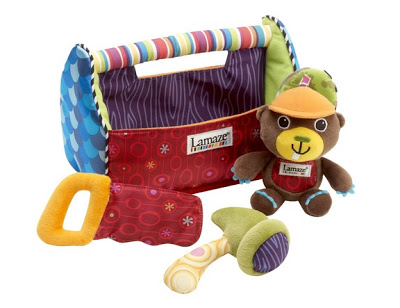
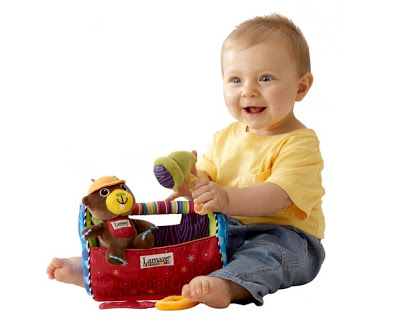
These sets are outward signs of the belief among adults that boys and girls have innately different skills and interests from birth. This assumption remains scientifically unproven yet culturally pervasive.
The cosmetics/tools dichotomy transcends class barriers, and therefore budgets. High-end toy manufacturers ‘Melissa and Doug’ whose products are stocked by middle class department stores such as John Lewis and Debenhams, have created a “Fill and Spill Pretty Purse”. The soft play set includes a mobile phone that chimes, a key ring with keys, a change purse with coins, and a makeup compact with a child-safe mirror “to powder little noses”. This language is important as it shows an awkward attempt to bridge the world of the child and the adult world.
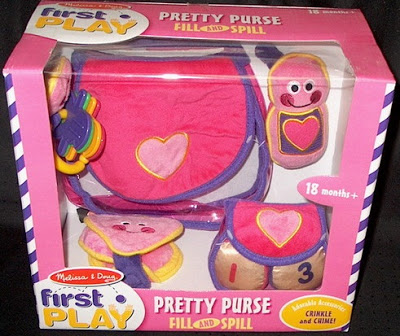
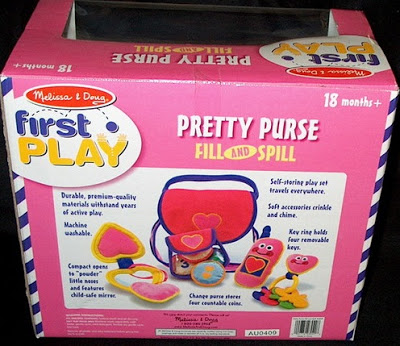
Melissa and Doug didn’t put much thought into creating their corresponding boys’ set, which is – drum roll – more tools! The 9-piece ‘Melissa and Doug Fill and Spill Toolbox’ includes a hammer, screwdriver, saw, nails, screws, blocks, and a drill that vibrates. Again, the word ‘pretty’ is used in the title of the girls’ product but omitted from the boys’.
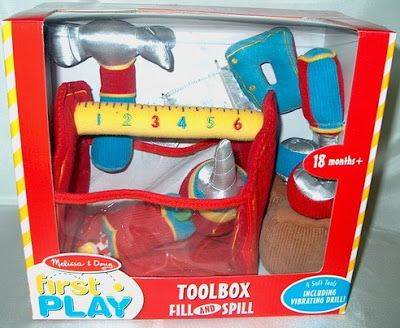
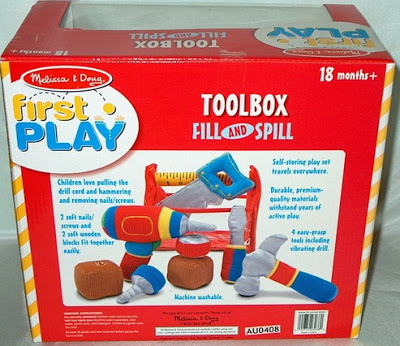
Then we have the “My First Toiletry Box” which is exactly the same idea but with even more emphasis on beauty. It includes a soft pink rattle hair brush, pink plush lipstick with bell inside, soft pink baby-safe mirror, and a pink and lilac comb which crackles. The contents clearly encourage little girls to define themselves from the outside in.
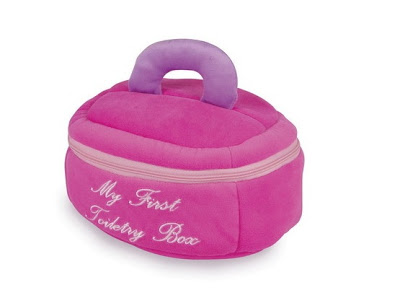
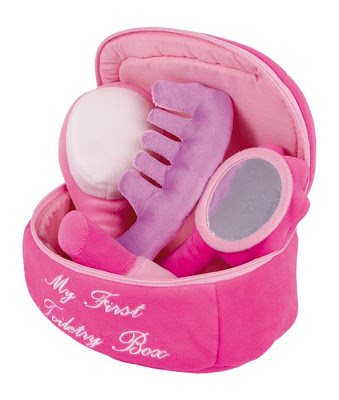
The boys’ version, yet again, exploits the ‘boys as future handymen’ ritual.
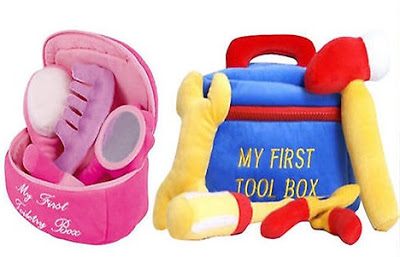
Notice how the girls’ items direct and confine a girl’s attention inward towards herself, whilst the boys’ items direct the boys’ attention outward towards his physical world, where there are limitless possibilities. The tool box lays the foundations for boys’ greater spatial awareness and understanding of physics (i.e. how objects interact with one another). It encourages movement and coordination. The toiletry box on the other hand, teaches girls that they can (and indeed should) focus all their efforts on boosting their attractiveness.
The leading soft toy manufacturer in the U.S., and also the oldest, ‘Gund’ have created various versions of what they have called their “My First Purse” over the years. Each version includes a cell phone with a mirror and a ringing IC chip, makeup compact with a rattle, and a change purse.
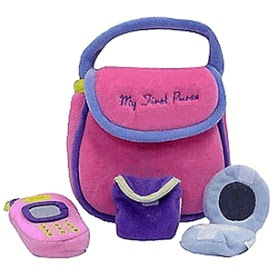
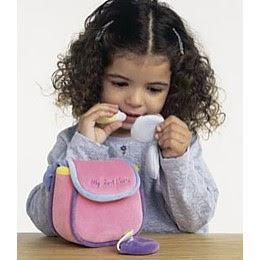
Predictably Gund have also created boys’ versions. The older set was a tool box and tools. The newer set is a laptop. It is suitable from birth and comes with a laptop case, mirrored screen, rattle mouse and disc that crinkles. This reinforces a more modern version of the same old ritual of boys as breadwinners, inventors and creatives, whilst girls live a narrow life of idle pleasure, a life turned in upon itself, self-absorbed and self-indulgent.
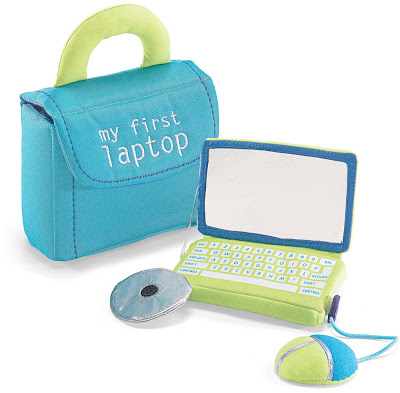
Curiously, Gund also produce another makeup set for baby girls which they have called “Gund Pretty as A Princess”. Here we see the ubiquitous “princess” marker, selling the idea that girls are princesses and should consider themselves as such (with all the attendant themes that accompany this narrative – a prince to the rescue, socialised passivity, being maintained rather than maintaining oneself). The set includes vanity carrying case, crinkling lipstick, rattling nail polish, and mirrored compact. It teaches girls very early in life that it is important how they look – and to look artificial. The product’s design features are those which girls have been socially conditioned to respond to: colours which are not too strong, curved and rounded shapes and flower decorations – and illustrates how such conditioning begins at birth.
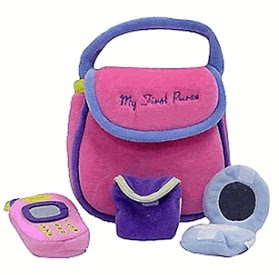
True to form, the boys’ counterpart is “My First Briefcase”. Here we see a perfect example of gendered job segregation, and the social construction of skill. In the product description Gund chirp:
“Help your ‘junior executive’ have hours of fun play with this charming playset. Includes everything a day at the office requires. Let baby close deals with the squeaky calculator, watch rattle, cell phone that jingles and of course– what executive could be complete without a big set of clicking crinkling car keys!”
These toys, and in particular their gender segregation, are an illustration of how patriarchal society passes on specific cultural messages through the medium of toys and, in this way, reproduces itself.
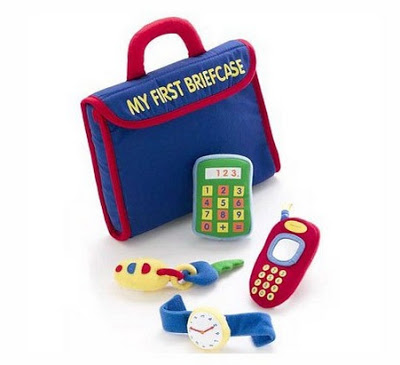
Notice how the briefcase set encourages boys to explore useful objects of the working world, familiarising boys with the appearance of numbers, mathematical symbols and clock faces. Also notice how the briefcase set embodies a variety of size, shape and colour concepts.
It seems bizarre to segregate boys and girls via their toys, particularly young babies, as they themselves have no concept of gender. However as I said in my analysis of the recent Early Learning Centre catalogue (here), there is commercial pressure to divide children along gender lines in this way. Gendering toys is a great way of nudging families toward buying more items per child. The more children share toys, the fewer toys get sold.
There is another, perhaps more obvious, reason why toy manufacturers segregate boys and girls – to appease what I refer to as the ‘mini-me fetish’. Many parents seem to be fixated on exaggerating the parent-child resemblance. They want their daughters to be ‘just like Mum’ and their sons to be aligned with their dads. Not ones to ignore an opportunity, toy manufacturers exploit this desire, and a self-fulfilling prophecy is created. Girls are nudged into passive roles, and boys into active roles. Here, we see toy manufacturers ‘Kidoozie’ use the phrase ‘just like mom’ on the packaging for their ‘My First Purse’.

This polyester and vinyl purse includes lipstick, soft mirror, set of keys, wallet, debit card and cell phone. Here we see the same flower symbols and pastel colours repeated again, just in case we were left with any doubt that this set is intended for girls.
The same colours and flower symbols are also used on this plush “My Purse” play set created by U.S. catalogue and online retailer Lilian Vernon.
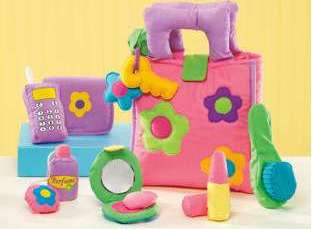
So apart from being told, and shown on the packaging, which sex these products are for, we have coded messages in the design, form and colour.
Almost identical pastel colours and flower symbols are used again on the “Galt Fill and Spill Baby Handbag”. Features include a mobile phone with a ringing tone, a teether keyring, crinkle purse and a flower mirror.
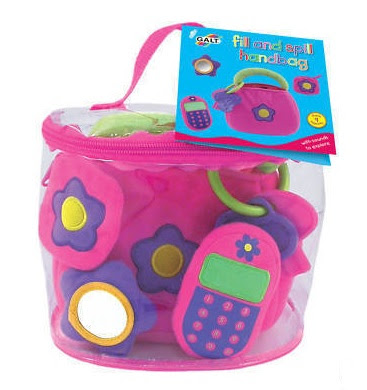
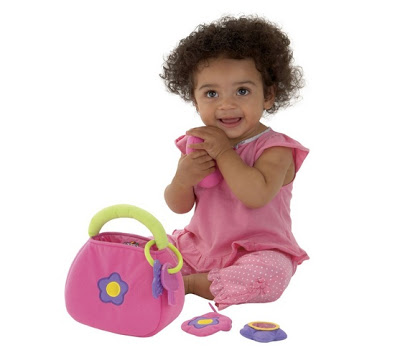
As well as flowers, another marker that girls are conditioned to respond to is fairies. The item specs of the “Liz Reversible Handbag” by Lilliputiens reads like a checklist of how to market adult items to the toddler market. The plush play set features flowers, fairies, pink shades, soft fabrics, and a doll, alongside adult items such as a cell phone, car keys, and an eye shadow compact. “Little girls proudly stroll around with this elegant handbag” asserts the product description.

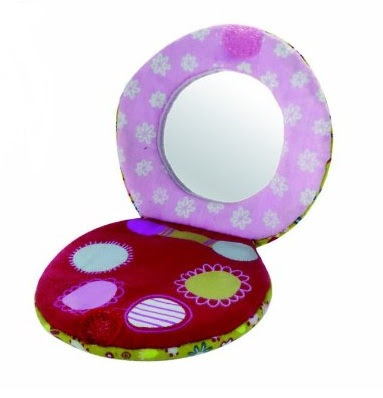
At the other end of the spectrum, some manufacturers make no attempt to include childish items, instead opting to provide plush baby-safe versions of entirely adult contents. “My First Makeup Set” by the ironically named, Learn and Grow describes itself as “a great gift for little girls 18mths – 3yrs”. The set includes lipstick, makeup compact, blusher brush, perfume and a random tube of ‘cream’, presumably facial cream. The contents are 100% focused on beauty. This sends the message to girls that their “dominant desire is to be desired” (Papadopoulos. L).
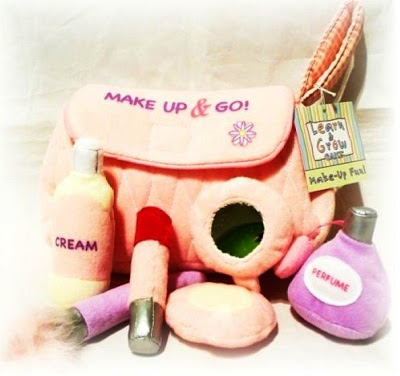
By far the biggest culprits in the ‘baby makeup business’ are Fisher Price. Founded in 1930, Fisher Price took pride in fundamental toy-making principles centred on intrinsic play value, ingenuity, strong construction, good value for the money, and action. However as time went on, some products slipped under the quality-control radar, such as this 1982 “My Pretty Purse” play set. The set included a handbag, realistic lipstick, keys, comb and mirror compact with powder puff.
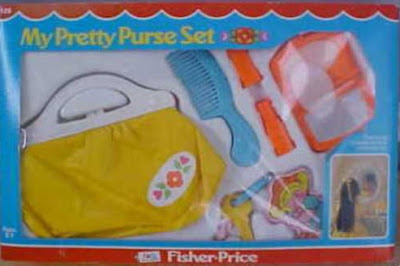
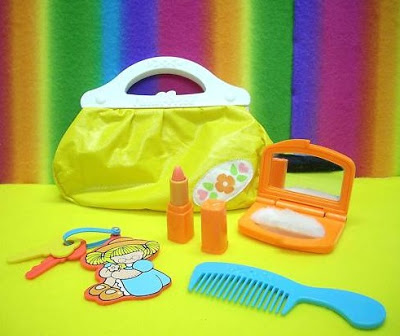
In 1992 when Fisher Price were purchased by toy giant Mattel, owner of Barbie, the flood-gates were blasted wide open on integrity. Consequently we ended up seeing products aimed at babies as young as 6 months such as “My Pretty Learning Purse” shown above, and the “Perfectly Pink My Pretty Purse” aimed at 3 month olds shown bellow.
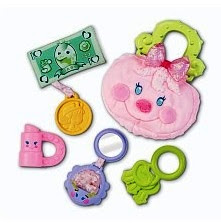
Marketing for this toy drew upon parents’ mini-me fetish. The product description cheerfully maintains that “When mom and baby are on the go, they never leave home without their essentials.” The plush purse includes a teethable handle, crinkly play money with teethable coin, mirrored compact, teethable keys, and teethable lipstick rattle.
Fisher Price used the same lipstick in their “Perfectly Pink Tummy Time Vanity Mirror”. The set is aimed at babies who are just learning to lift their head up, but are yet unable to sit unsupported. Expressly marketed at girl babies, the ‘vanity mirror’ has various cosmetic items attached, including a perfume bottle with a squeaking atomizer, a tactile hairbrush and rattle lipstick. The back side features a quilted design of “the princess kissing her frog.”
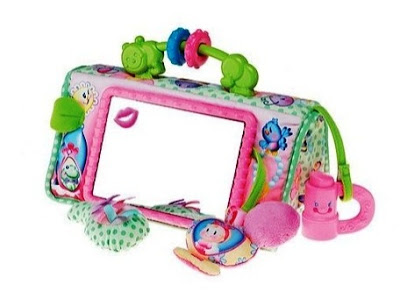
Using the phrase ‘vanity mirror’ to describe a baby’s toy is a depressing sign of how childhood is being eroded by profit-hungry manufacturers. The term Vanity originates from the Latin word ‘vanitas’ and is to do with futility and a rather overblown personal pride. Such self-regard, however is presented here as a good thing. Its use in toys is telling of how children are primed for lifetime of dissatisfaction in their appearance.
We only begin to understand the severity of such messages if we recognise that parents of babies and toddlers act as gatekeepers. Their infants are completely dependent on them. The toys they allow into their child’s world, and the cultural messages they embody, are perceived by the child as carrying explicit parental approval. Parents are the single most pervasive influence on children of this age range. They carry more influential clout than other family members, peers and the media combined. By allowing their child to interact with play things that are predominantly beauty-related they are telling their child that they value the principles implicit in those play things. In the case of the Fisher Price “Perfectly Pink My Pretty Purse” the principle is that you cannot leave home without cosmetics, and that these items are “essential”. The subliminal brainwash is that little girls are not beautiful the way they are.
Yet more lipstick can be found in the “My Pretty Purse” play set, or to give it its full name, the “Fisher Price Fun to Imagine! My Pretty Purse”. This item, which is reminiscent of the vintage 1982 set shown above, features a comb, cell phone, credit card, makeup compact, lipstick, makeup brush and keys. The small print on the box states “CHOKING HAZARD — Small parts. Not for children under 3 yrs.” However the product description refers to babies: “Keys, lipstick, money, music …this adorable purse has everything baby needs for learning and role play fun!” Prominent use of the word “fun” is telling of the particular marketing strategy at work here (more on this later).
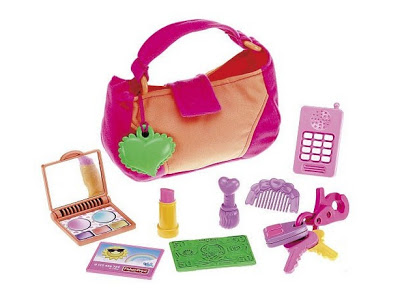
Baby makeup even penetrates into the well-thumbed realm of character merchandising, and predictably Fisher Price is the main perpetrator. The “Sesame Street Baby’s Purse” recommended for babies of 12 months contains a lipstick, a squeaking cell phone, a mirror, a comb, a change purse, and a key ring. The marketing blurb reads:
“For babies and toddlers who have places to go and people to see, this brightly colored Sesame Street-themed purse is just the thing. Well stocked, this fun accessory holds everything a jet-setting little person needs to be primped and proper. Mostly pink with a yellow handle and with Elmo’s and Zoe’s smiling faces on the flap, this chic purse is a must-have fashion item.”
To be fair, the marketing language is more gender-neutral than most products in this genre. Nonetheless, the product is still fashioned to appeal more to girls with the use of flower symbols, hearts and pinks, and featuring a girl prominently on the box.

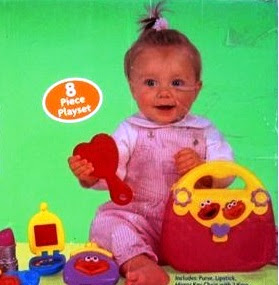
Toys don’t exist in a vacuum and character merchandising is one way in which they share close links with other aspects of the world of commercial culture handed down to children. Decorating toys with much-loved preschool characters enables the beauty culture to reach into every corner of children’s lives. Sesame Street feature once more on this plush baby cosmetics set by Gund.
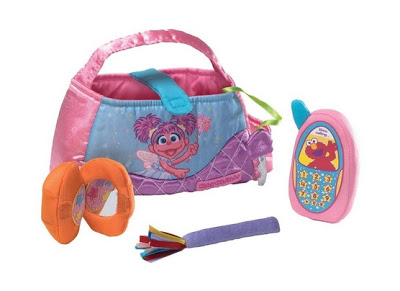
Predictably, Disney also have this one covered, using a central character no less.
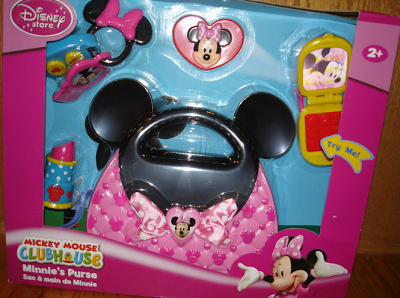
Aimed at toddlers, this set uses the much-loved character, Minnie Mouse, to lure little girls into the adult world of cosmetics. It contains a lipstick with realistic screw-up action, and a mirror compact to assist the girl in ‘putting on’ the lipstick.
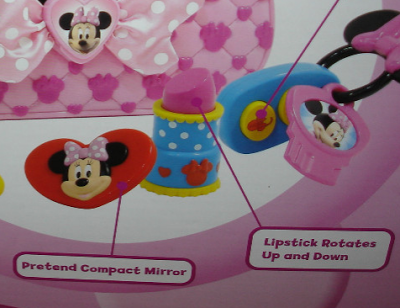
Another venture into the realm of character merchandising was made again by Fisher Price, this time based on the BBC CBeebies series for pre-school children ‘The Roly Mo Show’. This set named “Little Bo’s Rucksack” includes rucksack, play phone, lipstick, comb, mirror, busy book and bow “for you to wear.” The use of the word “rucksack” is gender-neutral but again, the contents are fashioned with girls in mind. Here they receive the message that bracelets and hair bows are an expected part of feminine ‘costume’.
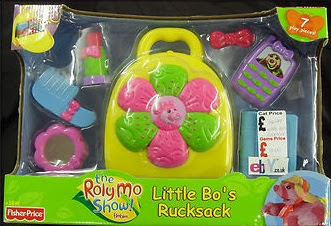
Before we leave Fisher Price, another notable product example is what they’ve called the “Fisher Price Little Glamour Gift Set” which is designed “for babies 3 months and older” and includes a diamond ring rattle, bracelet teether, and baby-safe mirror. Note the unfortunate use of the word ‘glamour’. Traditionally this word referred to ‘the traits or qualities that give happiness or pleasure to the senses.’ The contemporary connotation of the word speaks about to charm, personality, prettiness and sexual magnetism.
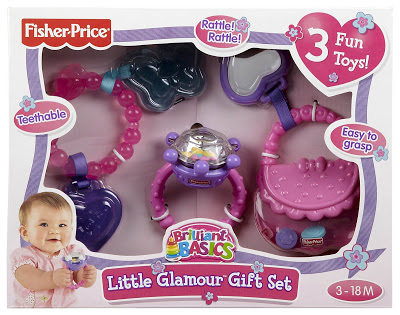
Whilst this set does not include any cosmetic items per se, it does feature a diamond ring which is a form of self-decoration. Perhaps more importantly, the ring is a symbol of engagement and a stunning example of how girls are taught to package themselves for the marriage market.
A similar diamond ring features alongside a lipstick, squeaky perfume bottle, and makeup compact in this “Beauty Box” created by Swedish company Oskar & Ellen. The company describe the set as “perfect for little girls who cannot keep away from Mummy’s make-up bag!” The application of gender in this description is lazy at best. Considering the target users of this toy are babies and toddlers, both girls and boys of this age have an interest in the contents of their mother’s make-up bag, or any bag for that matter. Yet in typical patriarchal fashion, Oskar & Ellen have expressly restricted their ‘beauty box’ to girls.
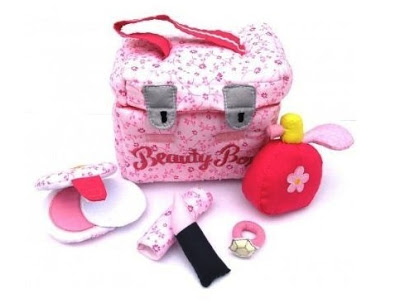
Oskar & Ellen also created a more elaborate version which they again restricted to girls. “A must-have bag for a Princess! Contains exciting grown-up items such as lipstick, nail varnish, eye shadow kit with applicator, powder compact, comb and hairdryer.”
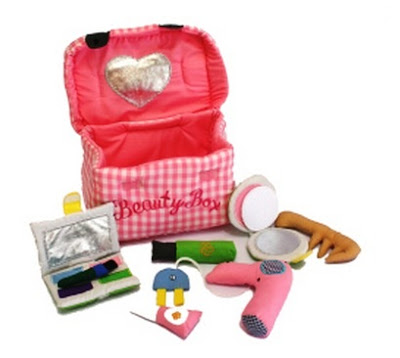
This version combines decoration of the face (makeup) with grooming of the hair (hairdryer). As peer pressure bears down when girls are a little older, the two intricate rituals will consume many hours of their life. Why infiltrate their tender years with them now?
The answer to this rhetorical question is shareholder satisfaction – aka – profits. In their relentless quest to maximise profits, some toy companies have focused on hair grooming as a genre in itself. Large toy manufacturer Little Tikes created the “Little Tikes Discovery Sounds Hair Drier” aimed at babies from 6 months of age. “Press the pink button to hear fun hair drying and other bubbly sounds” the packaging instructs. Notice prominent use of the popular yet purposively vague word “fun”. Using this word is a deliberate marketing technique. There’s less of the grown-up in it and more of the child; it has less to do with the role of sex object and more to do with play; it’s what manufacturers of ‘beauty-related’ toys want to pretend their products provide for children. How else could they attempt to justify their activities?
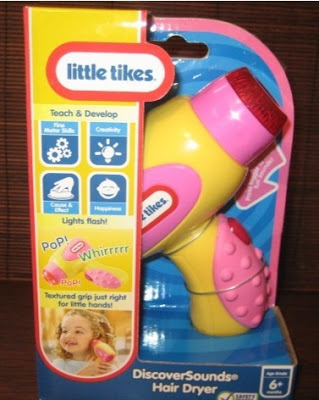
Another toy, “My First Haircut”, is made by a company called “Early Years” and distributed by “International Playthings”, the same company that works with the Early Learning Centre. With these links in mind, the design of the product is unsurprising. Marinated in pink and with a girl prominently displayed on the packaging, this set includes soft scissors that “pretend” cut, a crinkle comb, a hand mirror that rattles and a hair dryer which hums. None of the items are functional.
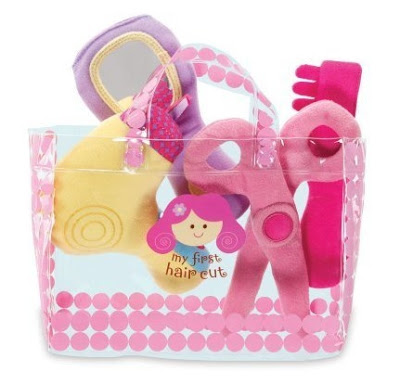
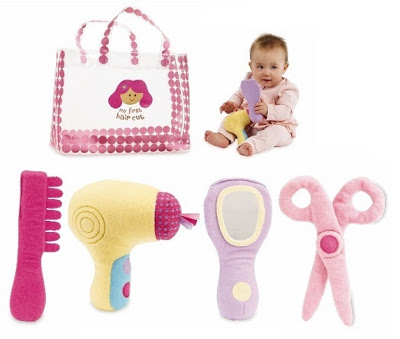
Arguably this set could be used to prepare an infant for their first trip to a hair salon. However the use of soft pastel colours and female character needlessly restrict the set to girls.
More hair grooming paraphernalia can be found alongside cosmetics in “My Beauty Bag” by ‘One Step Ahead’, a company specialising in “quality, innovative baby products”.
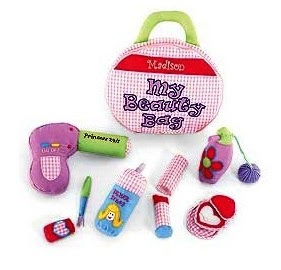
Virtually the same items feature in “My Beauty Kit” manufactured by Play Inc (bellow). The company assure us that “these cute pretend equipment and cosmetics are just as realistic as what mom has, only we have made them squeezably soft and safe for toddler girls.” The set is listed on their website under “Educational Toys”. The description states: “Looking this good doesn’t come easy. A little beauty goes a long way and it’s time well spent for children by building their dexterity and engaging with adults through role play. Who knew looking fabulous could also promote social and cognitive development and build motor skills?” Talk about stretching the acceptable ambit of marketing hyperbole.
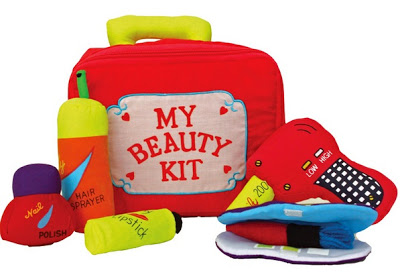
Another set of the same name but produced by a different company (Amelie’s Room) features a hairdryer, comb and several hair rollers. Of course it wouldn’t be a beauty kit without various cosmetics items – lipstick,nailpolish, powder compact with powder puff, makeup compact with applicator, and perfume. “Perfect from newborn and beyond” the manufacturer chirps, followed by an ironic emphasis on the organic features of the product: “Amelie’s Room uses natural fabrics inside and out. Our designs are simple and naturally soft on baby’s delicate skin.”
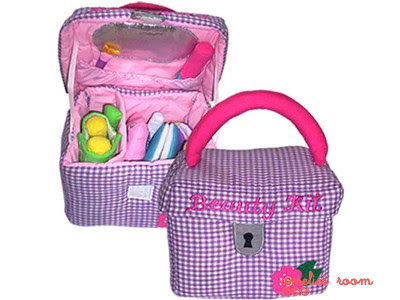
Other manufacturers are less obscure about the adult premise of their product. The manufacturer’s description of “My First Purse” by Alma’s Design is worth sharing in its entirety:
“Just let me get my purse and I’ll be ready to go. Oh, wait. Is that my phone? Oh, excuse me, I just have to take this. This purse is the perfect accessory to promote role playing with adults and build motor skills. It’s so valuable that imaginative young minds will want to carry it with them everywhere. They’ll be ready to set the next big trend with the fabulous pink, purple and yellow purse colors, their very own cell phone and address book, a comb, a compac, lipstick, and a coin purse for bargain shopping. All the essentials are perfectly contained in a simply stunning little bag. It’s just a wonderful way to tie together any ensemble.”
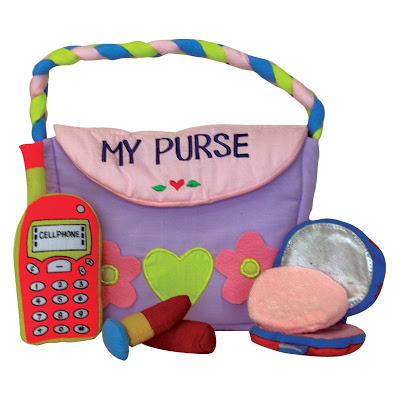
Other manufacturers are even more transparent about their product’s ‘adultification’ of children. American online shopping catalogue The Lakeside explain that their “My First Purse” comes with “plush pieces to helpyour toddler pretend she is a grown-up lady.” Contents include a lipstick, compact with mirror and powder puff, cell phone, and another item that keeps popping up in these toy sets – credit cards.
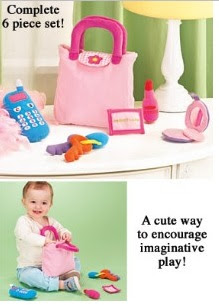
Credit cards and the general theme of consumption take centre stage in the “Happy Day Handbag” from international toy company Manhattan Toy…
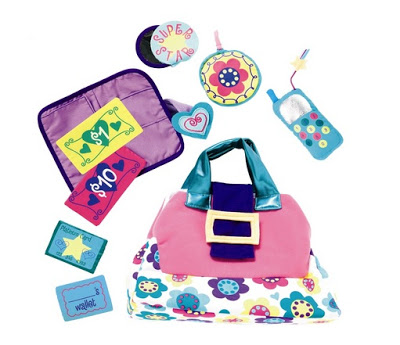
…and also in the “Bright Start Pretty in Pink Put & Take Purse” which includes pieces of crinkle money. In these toys we see the adult values of narcissism, consumerism and materialism at the fore.
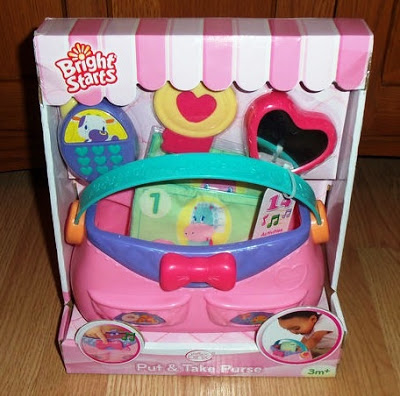
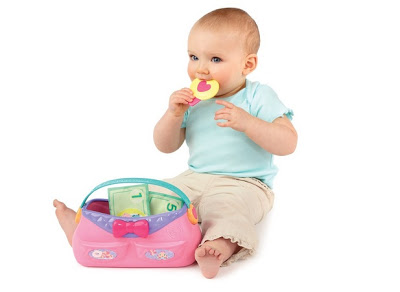
So far we have only examined plush and plastic cosmetics sets aimed at infants. However alongside cuddly lipsticks and wipe-clean makeup compacts, manufacturers also market wooden versions. As babies grow into toddlers and toddlers grow into preschoolers, cosmetics sets become more solid in texture and the pieces become smaller, more plentiful in number and more intricate. Here we see the “My Vanity Set” by French company Djeco which features various wooden cosmetics “so that your little princess can make herself beautiful”, and curiously “three pretty cards that can be used for tokens for beauty salon games”. The set is decorated with the usual markers of girlhood – soft pastel colours, flowers, hearts and bows.
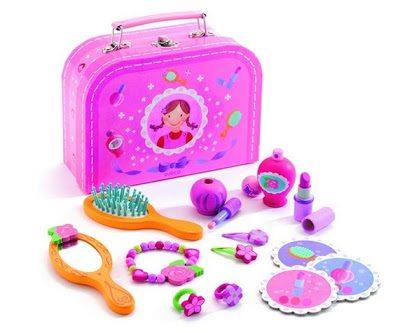
On the other hand, Thailand toy company ‘Santoys’ (short for ‘Santa’s Toys’) take a complete adultification approach with their comprehensive wooden set reminiscent of a makeup artists’ kit. The marketing reminds girls of the importance of looking fashionable at all times: “Make sure you get that red carpet look where ever you go with this portable cosmetics set”. These products set the agenda for a ceaseless round of triviality and self-indulgence. There’s little room for anything else. When playing with such toys, girls learn that appearance and attractiveness are central to their worth.
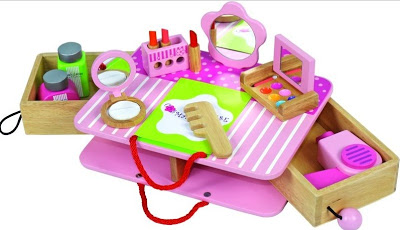
It would appear that in the relentless search for novelty, and therefore profits, no area of the child’s domain is left untouched. Relatively new to the toy world, fledgling company Alex Toy has devised a product to get beauty into the bathroom of toddlers. The “Alex Rub a Dub Pretty in the Tub
” set encourages toddlers to “primp and play in the tub!” “Floating vanity makes it fun!” The set contains a comb, pretend perfume bottles that function as squirters, and a child-safe vanity mirror.

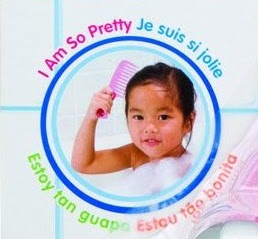
Another perfume bottle can be found in the “Baby on the Go – Purse Teether” by Safety 1st. The marketing blurb reads: “Your little consumer will be prepared for everything with her first Purse Teether. Our combination of teether and action toy will provide soothing relief to baby’s sensitive gums while the compact mirror, little credit card and bottle of perfume will put a smile on her face for hours”.
Yes, the company appear to believe that a cheap piece of moulded plastic will make your baby girl smile for hours. Because she’s that shallow.
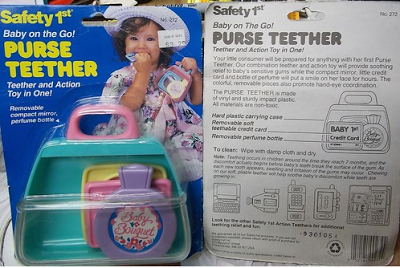
You would be forgiven for assuming that ‘baby makeup’ products are restricted to toy form, however, sadly this is not the case. Several companies have created ‘baby-safe’ versions of genuine cosmetics. One such brand is titled “Piggy-Paint” and focuses on nail varnish. The company website proudly displays several testimonials from customers. One of them leaps out:
“I just wanted to say thank you so much. I got my daughter’s nail polish today and it is beautiful on her ….she is only 3 months old and I felt completely fine putting this product on her”.
Another testimonial on the website reads:
“My Piggy Paint just arrived!! That was super quick!! I can’t wait till my grandbaby’s nap! She will wake up with pink piggys!!”
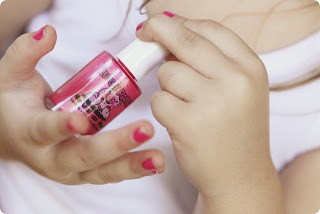
Needless to say, there is no benefit to an infant of getting their nails painted. Babies have no natural interest in this grooming ritual. The site even alludes to this fact by suggesting that caregivers distract the youngster:
“Since most young children are squirmy during the drying process of any polish, we suggest singing songs to pass the time.”
Here we see the company introducing child-like elements (singing songs) to mask an adult activity (applying cosmetics). This approach is similar to that applied by Fisher Price and their competitors in the toys discussed above.
Using the dialog of childhood in their marketing (“fun”, “dance”, “dream”) and in their product labelling (colours include “glitter bug”, “glass slippers”, “fairy fabulous”) Piggy-Paint obscures the inappropriateness of their product. Such language pacifies parents, and eases any instinctive guilt they may have.
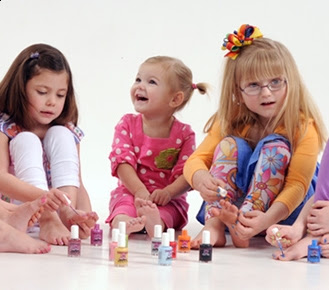
Another strategy is to emphasise danger-limitation by using words such as “safe”, “eco-friendly” and “natural” (cosmetics are many things, but they can never be said to be ‘natural’). The company tagline is: “As natural as mud”. Here they are using mud, a substance associated with childhood.
As well as reassuring parents that such products are suitable for young children, companies fabricate educational benefits for their products. The Piggy-Paint website proudly claims that their cosmetics can be used as “learning tools” to teach young children “fine motor skills” and “colour names”, even going so far as to say that applying cosmetics to your child will be a “bonding experience”.
Finally, for sake of completeness, we come to the category of apparel.
The type of clothing that adults chose for their infants can embody messages about beauty, and for the purposes of this article, messages about the use of cosmetics. Adults may purchase clothing for their daughters (it is always girls’ clothing) that sends an explicit message about cosmetics, such as this top for 2 year olds from Tesco sub-brand Cherokee.
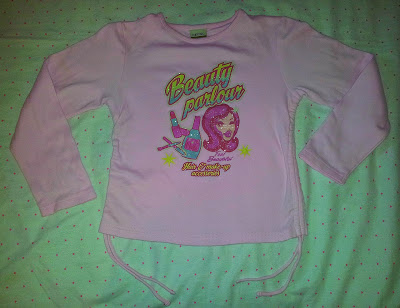
…and this top from Mothercare for babies aged 3-6 months featuring the words “Girls Things” and accompanied by lipstick, high heels and handbag embellishments.
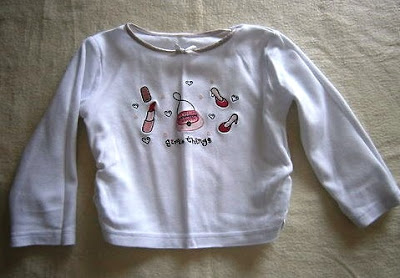
…as well as this top from Next for 2-3 year olds. It features lipstick, perfume, earrings, handbags and other beauty paraphernalia accompanied by the slogan, “For the modern girl, shoes, bags & jewellery are a girl’s best friend!”

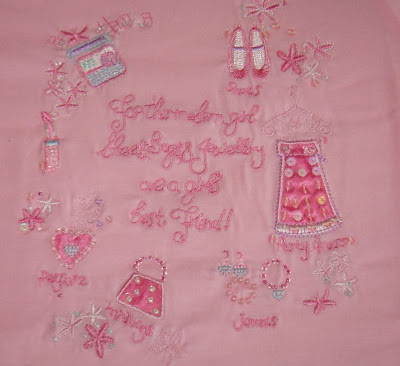
…and this top from United Colors Of Benetton for 2-3 year olds which features the slogan, “I love my pink lipstick”.
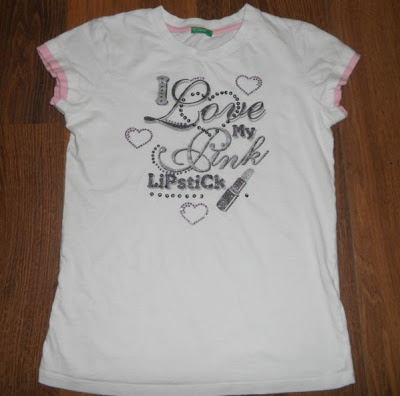
Or parents may chose clothes that simply feature images of cosmetics, such as this top from Gap Kids.

Or these pyjamas for 12-18 month olds, covered in lipstick prints.

Or this Barbie swimsuit, also for 12-18 month olds, also featuring lipstick.

Alternatively parents may purchase a ‘dress up’ outfit from the vast array designed to resemble the uniforms of beauty therapists, hair dressers and makeup artists, aimed at toddlers 1-3 years old.
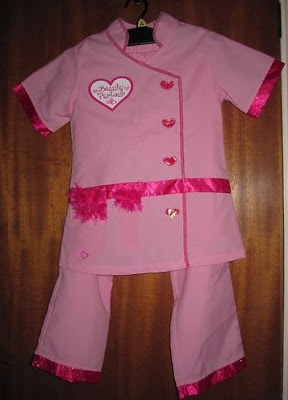
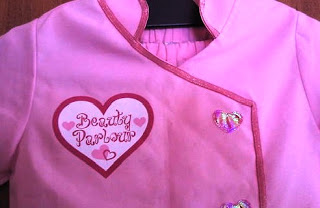
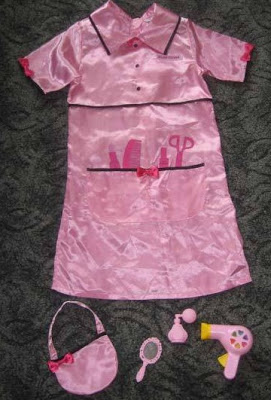
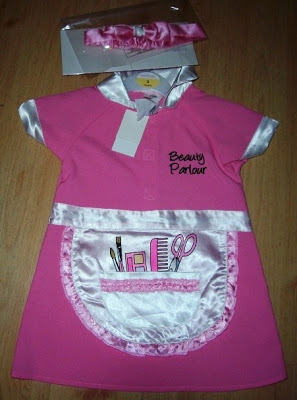
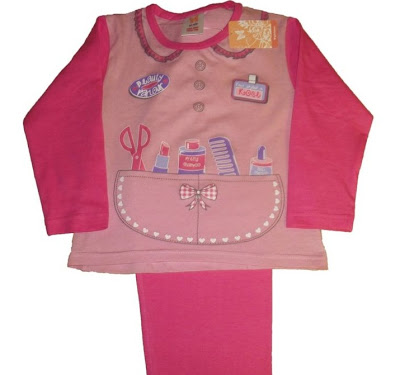
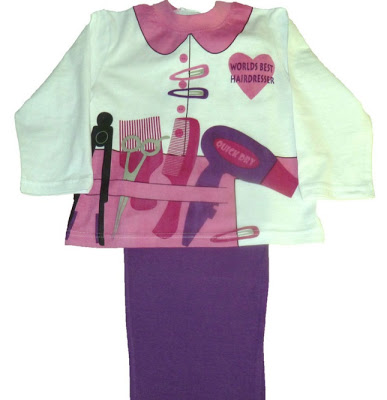
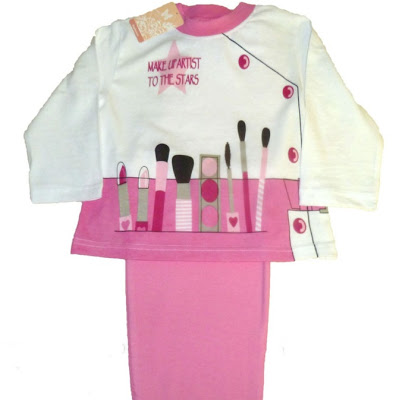
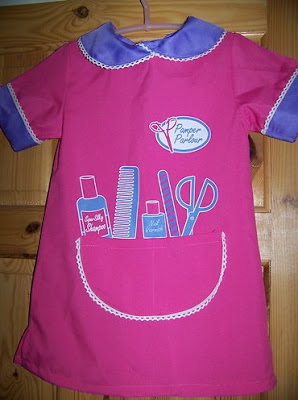
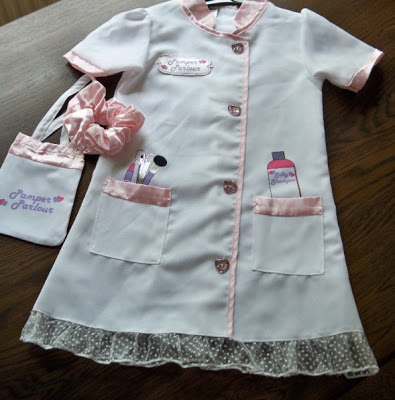
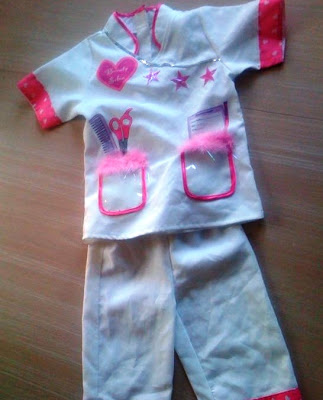
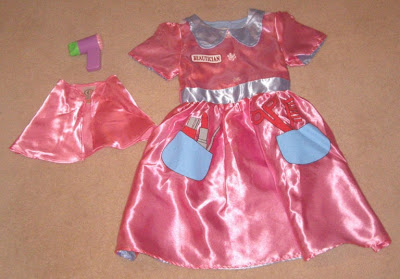
The outfit above is reversible, so when girls get bored of playing beautician, they can turn the outfit inside out to reveal… a nurses outfit! The message is clear: girls are only good at tending to others’ needs.
The outfits featured here, and the toys discussed above, form the building blocks for a dumbing down of aspirations. They teach Girls to prioritize certain rewards (male attention) over other rewards (academic accomplishment), thus limiting their future educational and occupational opportunities.
Conclusions
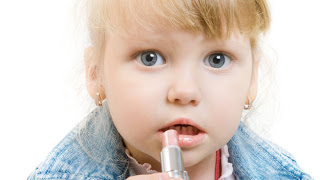
Toys make up (no pun) a large part of a child’s world from a very early age and are very important in laying the foundations for the child’s future attitudes and ideas. Makeup toys prime girls for a lifetime of chasing rigid norms of physical attractiveness through the consumption of cosmetics and fashionable accessories. In encouraging girls to value themselves for their appearance over other attributes, such toys are the first step on the ladder of sexualisation. The American Psychological Association maintains that sexualisation occurs when “a person’s value comes only from his or her sexual appeal or behavior, to the exclusion of other characteristics” (Report of theAPA Task Force on the Sexualisation of Girls 2007).
The products I have examined here are aimed at very young children, in some instances, newborns. They show how children get quite a lot of Patriarchal nudges which they can’t be conscious of. There can be no innate desire on the part of babies, either girls or boys, to play with makeup. Another way of looking at it is that manufacturers, in their never-ending drive for profits, are robbing children of their childhood.
The argument which manufacturers of beauty toys put forward – that they’re only catering for demand – has some truth in it, but they also help to create demand. It’s a chicken and egg scenario. Cosmetics are presented to girls as part of normal life. Likewise, playing with cosmetics-related toys is presented to parents as a natural facet of childhood inquisitiveness. Yet whatever else might be said about cosmetics, they simply can’t be called ‘natural’ so playing with them can’t be natural either.
Share the word – Pin it!
